January to December, 2024
Introduction
About the Ontario Employment Report – January to December, 2024
The Ontario Employment Report is released four times a year and provides an assessment of the current trends and developments in the Ontario labour market. The Ontario Employment Report is a companion report to the Ontario Economic Accounts, which provides an overall assessment of the current state of the Ontario economy.
The report for the fourth quarter of 2024 provides an assessment of Ontario’s labour market for the entire year, comparing annual averages, while the first through third quarter reports measure year-over-year changes in quarterly data.
Overview
Key labour market indicators, 2024
Employment:
- +140,000 net jobs in 2024, year-over-year
- +78,600 net full-time jobs in 2024, year-over-year
Unemployment rate:
- 7.0% in 2024
Participation rate:
- 65.3% in 2024
Employment change by province, 2024
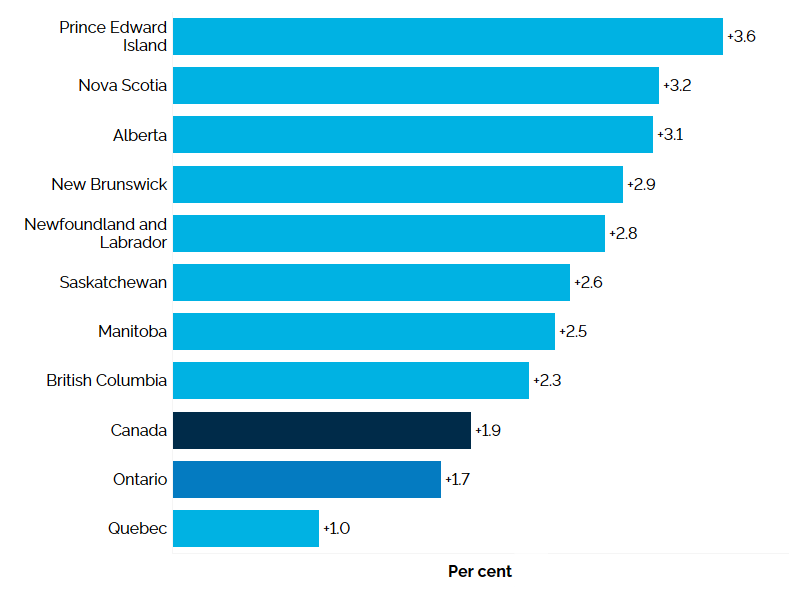
The horizontal bar chart shows the per cent annual employment change for the ten Canadian provinces and Canada. The highest rate of employment increase was recorded in Prince Edward Island (+3.6%), followed by Nova Scotia (+3.2%) and Alberta (+3.1%). The smallest rate of employment growth was observed in Quebec (+1.0%). Ontario had the second smallest rate of employment growth (+1.7%). Canada’s employment increased by 1.9%.
In 2024, Ontario’s employment increased by 1.7% (+140,000). This followed an increase in 2023 (+3.1%) and notable increases in 2022 and 2021 (+4.9% and +5.1%, respectively).
In 2024, employment increased in all provinces. While Ontario had the largest employment increase (+140,000) among provinces, its percentage growth in employment (+1.7%) was slightly below the national average (+1.9%). Ontario’s percentage increase in employment was the second smallest among the provinces, after Quebec (+1.0%). Prince Edward Island recorded the largest percentage increase in employment (+3.6%).
Ontario’s labour market, 1976-2024
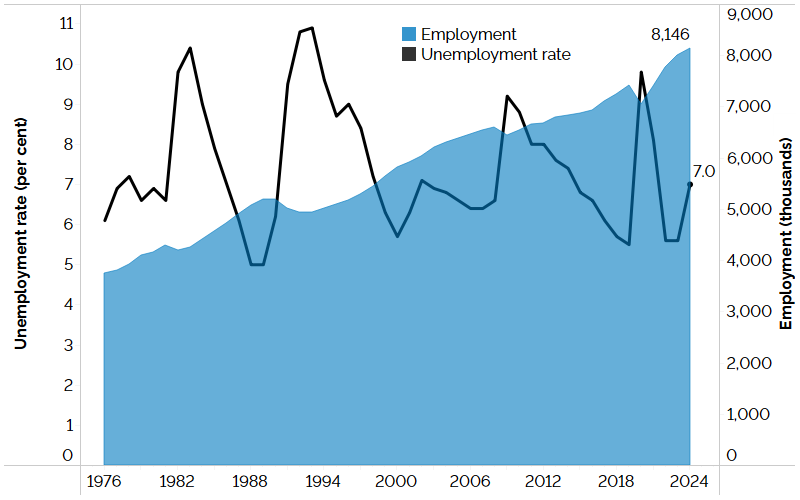
The combination line and area chart shows Ontario’s unemployment rate (line chart) and employment (area chart) from 1976 to 2024. Ontario’s unemployment rate has fluctuated reaching 7.0% in 2024. Employment in Ontario has risen steadily since 1976 with a few exceptions when employment contracted during recessions. The employment level in 2024 reached approximately 8,146,000, the highest level on record.
In 2024, the unemployment rate in Ontario was 7.0%, above the Canadian rate (6.3%). Ontario’s unemployment rate increased by 1.4 percentage points between 2023 and 2024 and was the highest rate since 2014, excluding the pandemic years (2020 and 2021).
In 2024, Ontario’s labour force participation rate went down by 0.3 percentage point to 65.3%, which was slightly below the Canadian rate of 65.5%.
Ontario’s employment rate declined to 60.7% in 2024 from 62.0% in 2023, as the employment growth (+1.7%) did not keep pace with population growth (+3.8%) in the Labour Force Survey (LFS). LFS population increases in 2023 and 2024 (+2.8% and +3.8%, respectively) represented the largest increases on record.
Highlights in 2024
- Employment increased among full-time workers (+1.2%) and part-time workers (+4.5%).
- Labour Force Survey population grew by 3.8%, the highest rate on record.
- Private sector employment experienced the largest growth (+54,400, +1.0%), while public sector employment (+3.3%) and self-employment (+3.1%) also increased.
- Employment increased in the services-producing industries (+2.7%) but declined in the goods-producing industries (-2.2%).
- Among major industries, the professional, scientific and technical services industry experienced the largest growth (+7.5%).
- Among broad occupational groups, management occupations and natural and applied sciences and related occupations saw the largest increases in employment.
- Employment increased in all five regions, with Southwestern Ontario (+3.5%) recording the highest percentage increase in employment.
- Employment growth was driven by employment increases for core-aged workers (+2.8%), while youth employment (-0.6%) and employment of older workers (-0.1%) declined slightly.
- Among core-aged individuals, employment levels increased for those with a university degree (+10.1%), while employment for those without a university degree declined.
- Actual average weekly hours worked per worker decreased, while total economy-wide weekly hours worked reached their highest level since 1976, driven by continued employment growth.
- The average hourly wage of employees was $36.44, an increase of 2.8% after accounting for inflation.
- The unemployment rate increased by 1.4 percentage points to 7.0%, the highest rate since 2014 excluding the pandemic years.
- The share of those unemployed for 27 weeks or more increased to 22.4% (+5.7 percentage points).
- The participation rate declined, with the youth participation rate reaching its lowest point since 1976, excluding the pandemic low in 2020.
Type of work
Employment change by full-time, part-time status, Ontario, 2024
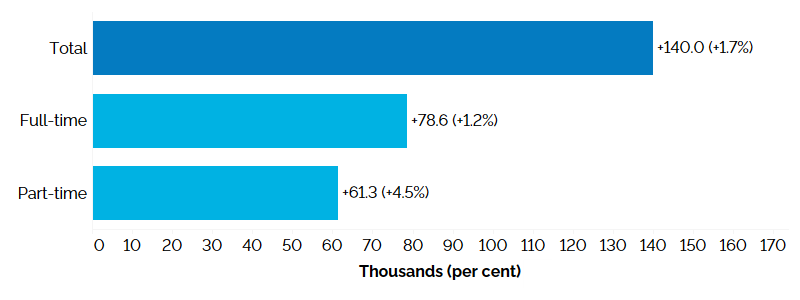
The horizontal bar chart shows Ontario’s annual employment change by full-time and part-time status, measured in thousands of jobs with percentage changes in brackets. Total employment increased by 140,000 (+1.7%), with full-time employment increasing by 78,600 (+1.2%), and part-time employment increasing by 61,300 (+4.5%).
In 2024, employment in Ontario increased by 1.7%, driven by increases in both full-time (+78,600, +1.2%) and part-time positions (+61,300, +4.5%).
Part-time employees experienced disproportionate job losses during the COVID-19 pandemic. In 2024, part-time employment exceeded its 2019 level for the first time (+4.3%), while full-time employment was 11.2% above its 2019 level.
Employment change by employment sector, Ontario, 2024
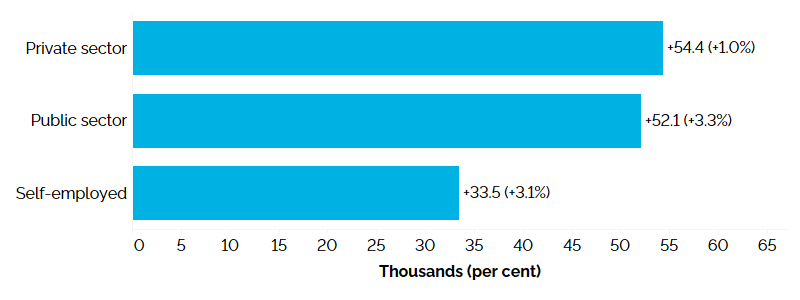
The horizontal bar chart shows Ontario’s annual employment change for the private sector, public sector and the self-employed, measured in thousands of jobs with percentage changes in brackets. Employment increased in the private sector (+54,400, +1.0%), the public sector (+52,100, +3.3%) and for the self-employed (+33,500, +3.1%).
The private sector had the largest increase in employment (+54,400), followed by the public sector
In 2024, self-employment was still below its 2019 pre-pandemic level (-35,700, -3.1%), while both private sector and public sector employment exceeded their 2019 levels.
Industry and occupation
In 2024, employment decreased in goods-producing industries (-35,500, -2.2%) and increased in services-producing industries (+175,400, +2.7%).
Employment change by industry, goods-producing industries, Ontario, 2024
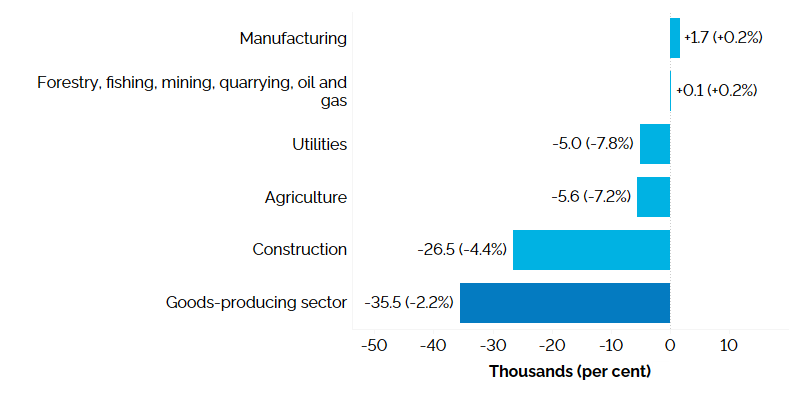
The horizontal bar chart shows Ontario’s annual employment change by industry for goods-producing industries, measured in thousands of jobs with percentage changes in brackets. Employment in most goods-producing industries decreased including construction (-26,500, -4.4%), agriculture (-5,600, -7.2%) and utilities (-5,000, -7.8%). Manufacturing (+1,700, +0.2%) and forestry, fishing, mining, quarrying, oil and gas (+100, +0.2%) experienced increases in employment. The overall employment in goods-producing industries decreased by 35,500 (-2.2%).
Most goods-producing industries saw a decline in employment in 2024. The construction industry recorded the largest employment decline (-26,500), followed by agriculture (-5,600) and utilities (-5,000). Manufacturing (+1,700) and forestry, fishing, mining, quarrying, oil and gas (+100) experienced growth in employment levels. According to BuildForce
Employment change by industry, services-producing industries, Ontario, 2024
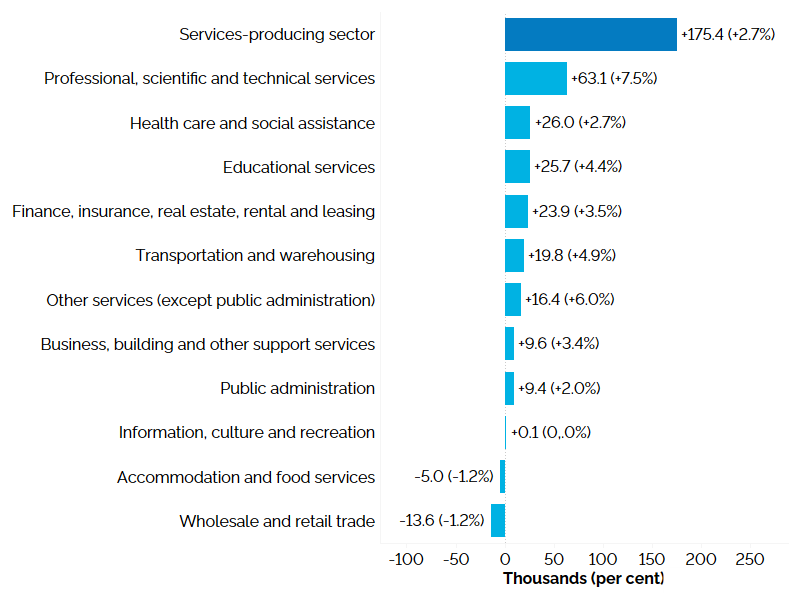
The horizontal bar chart shows Ontario’s annual employment change by industry for services-producing industries, measured in thousands of jobs with percentage changes in brackets. All except two of the services-producing industries experienced an increase in employment, with the largest increase in professional, scientific and technical services (+63,100, +7.5%), followed by health care and social assistance (+26,000, +2.7%), educational services (+25,700, +4.4%) and finance, insurance, real estate and leasing (+23,900, +3.5%). Accommodation and food services (-5,000, -1.2%) and wholesale and retail trade (-13,600, -1.2%) experienced declines in employment. The overall employment in services-producing industries increased by 175,400 (+2.7%).
Almost all services-producing industries experienced employment growth in 2024. The professional, scientific and technical services industry (+63,100) had the highest employment growth, followed by health care and social assistance (+26,000) and educational services (+25,700). Wholesale and retail trade (-13,600) and accomodation and food services (-5,000) were the only services-producing industries that experienced employment declines in 2024.
Employment change by occupational group, Ontario, 2024 footnote 3
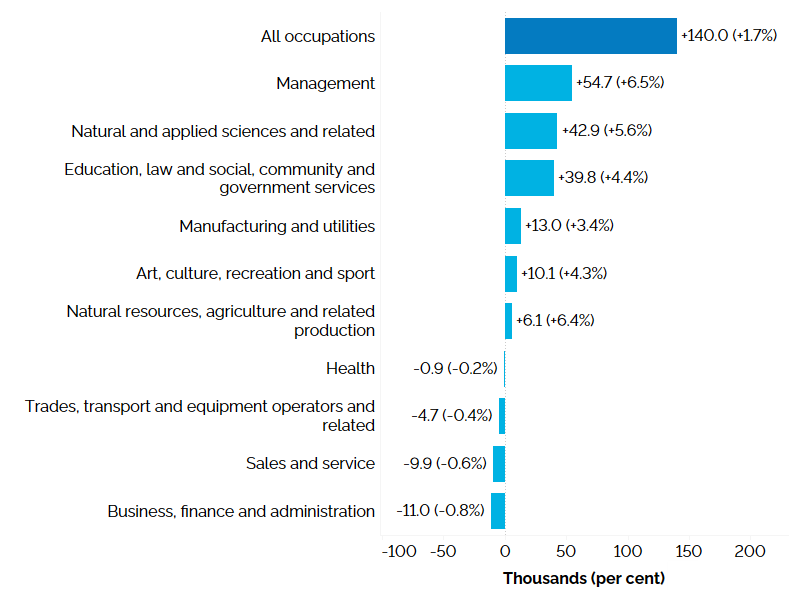
The horizontal bar chart shows Ontario’s annual employment change by broad occupational group, measured in thousands of jobs with percentage changes in brackets. Employment increased in six of ten broad occupational groups. Management occupations experienced the largest employment increase (+54,700, +6.5%), followed by natural and applied sciences and related occupations (+42,900, +5.6%); occupations in education, law and social, community and government services (+39,800, +4.4%); and occupations in manufacturing and utilities (+13,000, +3.4%). Four broad occupational groups experienced a decline in employment, led by business, finance and administration occupations (-11,000, -0.8%).
Among broad occupational groups, management occupations (+54,700) saw the largest increase in employment, followed by natural and applied sciences and related occupations (+42,900) and occupations in education, law and social, community and government services (+39,800). Occupations in four broad occupational groups experienced a decline in employment, led by business, finance and administration occupations (-11,000).
Regions
Employment change by region, Ontario, 2024
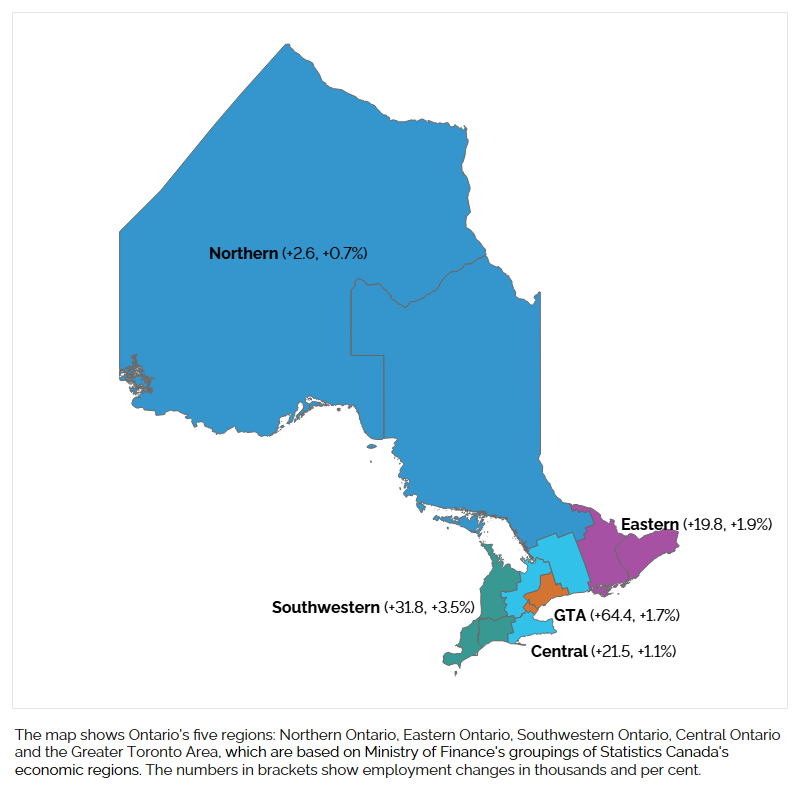
The map shows Ontario’s five regions: Northern Ontario, Eastern Ontario, Southwestern Ontario, Central Ontario and the Greater Toronto Area, which are based on Ministry of Finance's groupings of Statistics Canada's economic regions. The map shows changes in employment measured in thousands and percentages in each region. Employment increased in all Ontario regions in 2024, led by the GTA (+64,400, +1.7%) and followed by Southwestern Ontario (+31,800, +3.5%), Central Ontario (+21,500, +1.1%), Eastern Ontario (+19,800, +1.9%), and Northern Ontario (+2,600, +0.7%).
In 2024, all Ontario regions experienced employment growth. The Greater Toronto Area (GTA) experienced the largest employment increase (+64,400); however, Southwestern Ontario experienced the highest percentage increase in employment (+3.5%), followed by Eastern Ontario (+1.9%), the GTA (+1.7%), Central Ontario (+1.1%) and Northern Ontario (+0.7%).
Unemployment rate by region, Ontario, 2024
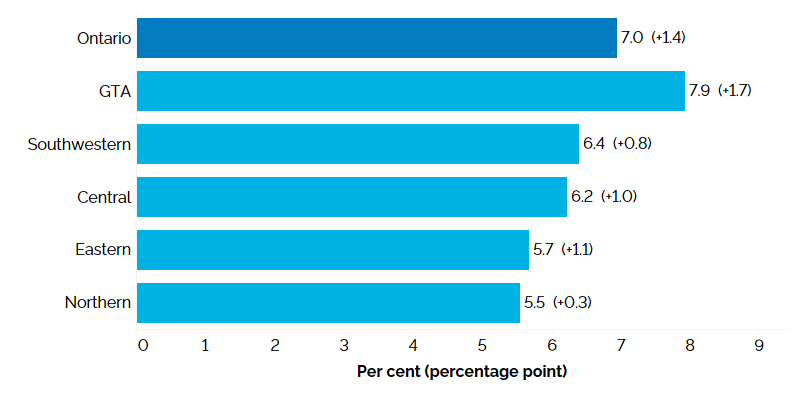
The horizontal bar chart shows unemployment rates by Ontario region in 2024, measured in per cent with annual percentage point changes in brackets. The Greater Toronto Area had the highest unemployment rate at 7.9% (+1.7 percentage points), followed by Southwestern Ontario (6.4%, +0.8 percentage point), Central Ontario (6.2%, +1.0 percentage point), Eastern Ontario (5.7%, +1.1 percentage points) and Northern Ontario (5.5%, +0.3 percentage point). Ontario’s unemployment rate in 2024 was 7.0% (+1.4 percentage points).
In 2024, the unemployment rate increased in every region, with the GTA experiencing the largest increase (+1.7 percentage points). The GTA had the highest unemployment rate at 7.9%, while Northern Ontario had the lowest unemployment rate at 5.5%.
Participation rate by region, Ontario, 2024
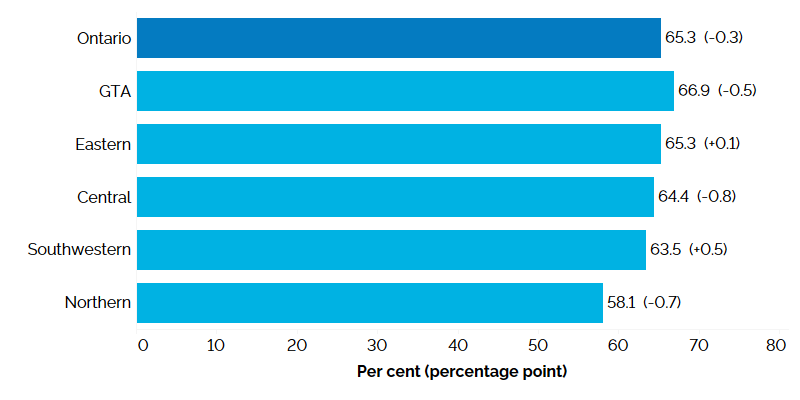
The horizontal bar chart shows participation rates by Ontario region in 2024, measured in per cent with annual percentage point changes in brackets. The Greater Toronto Area had the highest participation rate at 66.9% (-0.5 percentage point), followed by Eastern Ontario (65.3%, +0.1 percentage point), Central Ontario (64.4%, -0.8 percentage point), Southwestern Ontario (63.5%, +0.5 percentage point) and Northern Ontario (58.1%, -0.7 percentage point). The overall participation rate for Ontario was 65.3% (-0.3 percentage point).
In 2024, the participation rate declined in three out of Ontario’s five regions (Central Ontario, Northern Ontario and the GTA). The GTA had the highest participation rate (66.9%), while Northern Ontario had the lowest participation rate (58.1%).
Demographic groups
Employment change by age group and gender, Ontario, 2024
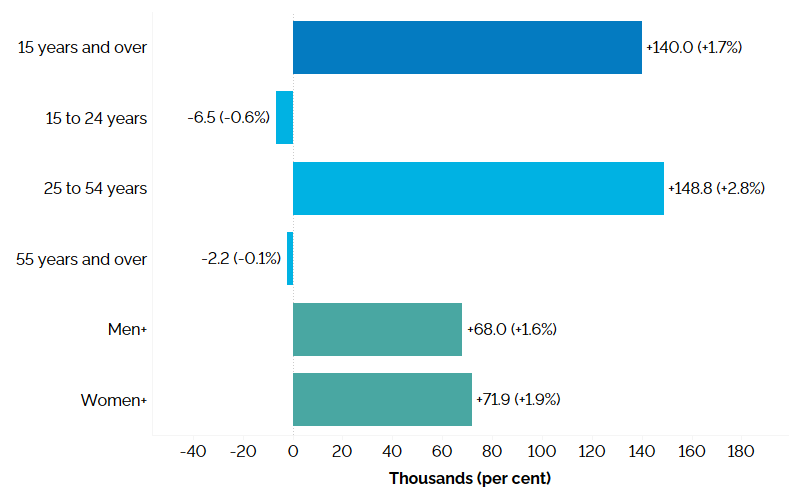
The horizontal bar chart shows Ontario’s annual employment change for three age groups, as well as by gender, compared to the overall population, measured in thousands of jobs with percentage changes in brackets. Ontarians aged 25 to 54 years experienced job gains of 148,800 (+2.8%). Employment decreased among those aged 15 to 24 years (- 6,500, -0.6%), as well as those aged 55 years and over (-2,200, -0.1%). Total employment (for population aged 15 years and over) increased by 140,000 (+1.7%). Men+ employment increased by 68,000 (+1.6%) and women+ employment increased by 71,900 (+1.9%).
In 2024, employment increased among core-aged workers aged 25 to 54 years (+148,800, +2.8%), but declined among older adults aged 55 years and over (-2,200, -0.1%) and youth aged 15 to 24 years (-6,500, -0.6%). Employment increased among both men
Employment change by education level, core-aged workers, Ontario, 2024
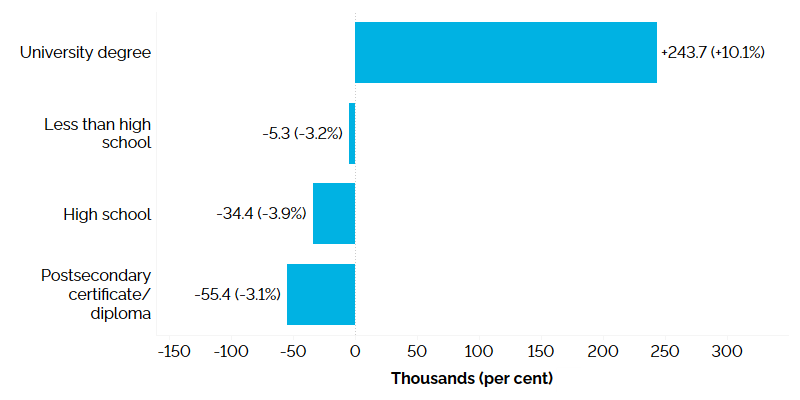
The horizontal bar chart shows Ontario’s annual employment change by education level for the core-aged population (25 to 54 years old) in 2024, measured in thousands of jobs with percentage changes in brackets. Employment increased among workers with a university degree by 243,700 (+10.1%). Employment declined for those with a postsecondary certificate/diploma (-55,400, -3.1%), high school graduates (-34,400, -3.9%) and those without a high school diploma (-5,300, -3.2%).
Among the core-aged population, employment increased among university graduates (+243,700, +10.1%), but declined among those with all other credentials. Employment among workers with a postsecondary certificate or diploma experienced the largest decline in employment (-55,400, -3.1%). Those with a high school credential (-34,400, -3.9%) and those with less than high school education (-5,300, -3.2%) also experienced declines in employment. These trends may have been driven in part by demographic changes, with the university-educated population accounting for all of the core-aged population growth, among these educational categories.
Employment change by immigrant status, core-aged workers, Ontario, 2024
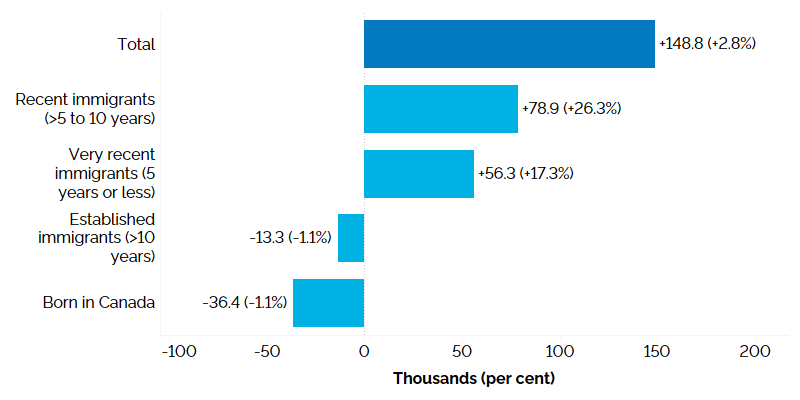
The horizontal bar chart shows Ontario’s annual employment change by immigrant status for the core-aged population (25 to 54 years old) in 2024, measured in thousands of jobs with percentage changes in brackets. Those born in Canada had the largest employment decrease (-36,400, -1.1%), followed by established immigrants who landed more than 10 years earlier (-13,300, -1.1%). Recent immigrants who landed between 5 and 10 years earlier (+78,900, +26.3%) and very recent immigrants who landed 5 years earlier or less (+56,300, +17.3%) experienced employment increases.
In 2024, employment increased among core-aged recent immigrants and very recent immigrants but declined among established immigrants and those born in Canada. Core-aged recent immigrants experienced the largest increase (+78,900, +26.3%), followed by very recent immigrants (+56,300, +17.3%). On the other hand, core-aged workers born in Canada experienced the largest employment decline (-36,400, -1.1%), while employment also declined among core-aged established immigrants (-13,300, -1.1%). These trends may have in part been driven by demographic changes, with recent and very recent immigrants driving the overall core-aged population growth.
Wages
Average hourly wages by employment status, Ontario, 1997-2024footnote 5
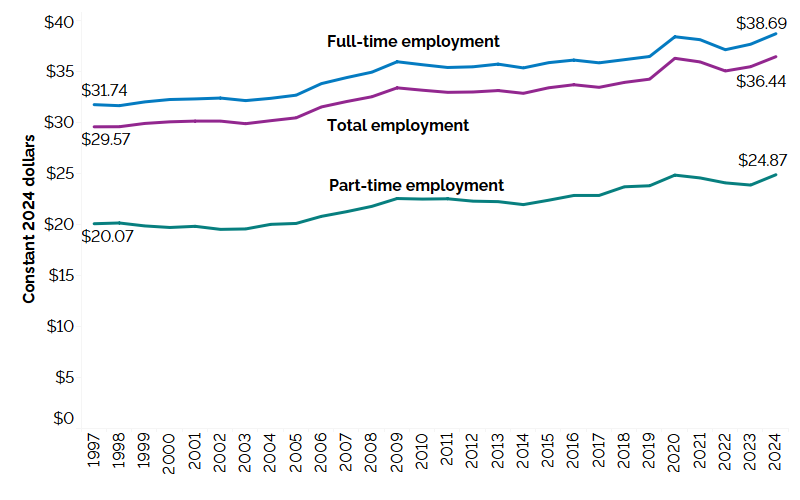
The line chart shows average hourly wages for all employees, full-time and part-time employees expressed in real 2024 dollars from 1997 to 2024. Real average hourly wages of all employees increased from $29.57 in 1997 to $36.44 in 2024; those of full-time employees increased from $31.74 in 1997 to $38.69 in 2024 and those of part-time employees increased from $20.07 in 1997 to $24.87 in 2024.
Over the last two and a half decades, the average hourly wage increased in real terms
Real hourly wage change by type of work, Ontario, 2024
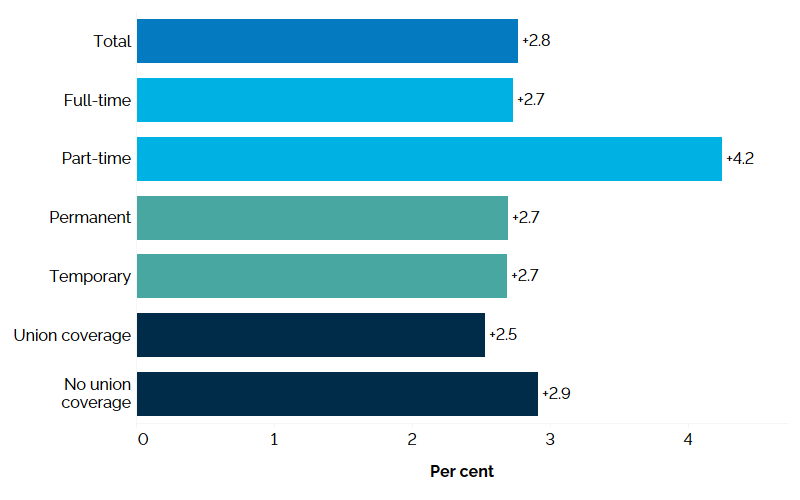
The horizontal bar chart shows the annual change in Ontario’s real hourly wages by type of work in 2024, measured in per cent. The average hourly wage increased by 2.8%. Real hourly wages increased for the following types of work: full-time positions (+2.7%); part-time positions (+4.2%); both permanent and temporary employment (+2.7%); jobs with union coverage (+2.5%); and those with no union coverage (+2.9%).
In 2024, the average hourly wage of Ontario employees was $36.44 per hour, an increase of 5.2% or 2.8% in real terms (after accounting for inflation of 2.4%)
Real average hourly wages increased by 2.7% for full-time employees and 4.2% for part-time employees in 2024. Real hourly wages increased by 2.7% for both permanent and temporary workers. Real hourly wages of unionized employees increased by 2.5%, and 2.9% for non-unionized employees.
Average hourly wage by occupational group, Ontario, 2024
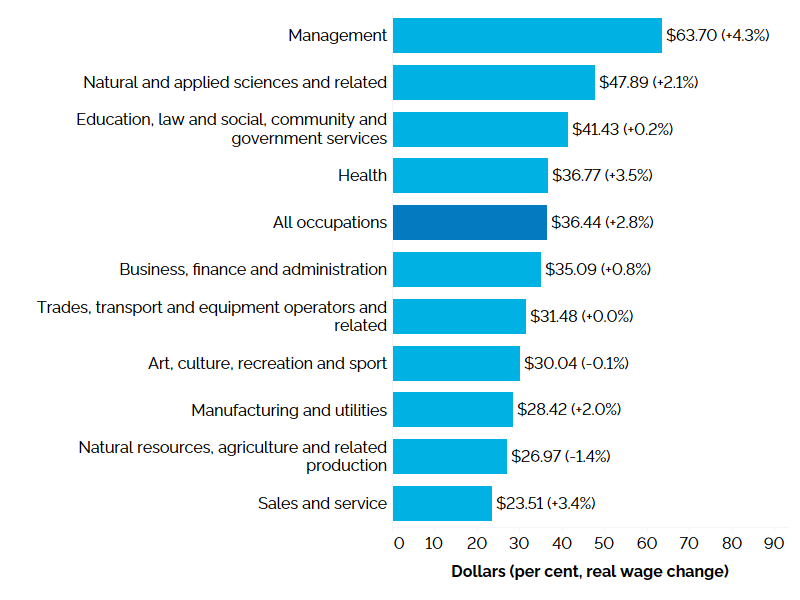
The horizontal bar chart shows average hourly wage rates in 2024, measured in dollars with per cent growth in real wages in brackets, by occupational group. In 2024, the average hourly wage rate for Ontario was $36.44 (+2.8%). Those in management occupations had the highest average hourly wage rate at $63.70 (+4.3%); followed by natural and applied sciences and related occupations at $47.89 (+2.1%); and occupations in education, law and social, community and government services at $41.43 (+0.2%). The lowest average hourly wage rate was for sales and service occupations at $23.51 (+3.4%).
In 2024, employees in management occupations had the highest average hourly wage ($63.70), followed by natural and applied sciences and related occupations ($47.89) and occupations in education, law and social, community and government services ($41.43). Employees in sales and service occupations had the lowest average hourly wage ($23.51).
Management occupations recorded the largest annual increase in real average hourly wages (+4.3%), followed by health occupations (+3.5%), and sales and service occupations (+3.4%). On the other hand, natural resources, agriculture and related productions occupations (-1.4%) and occupations in art, culture, recreation and sport (-0.1%) were the only occupational groups to record a decline in real average hourly wage rates.
Hours Worked
Total weekly hours worked, Ontario, 1976-2024
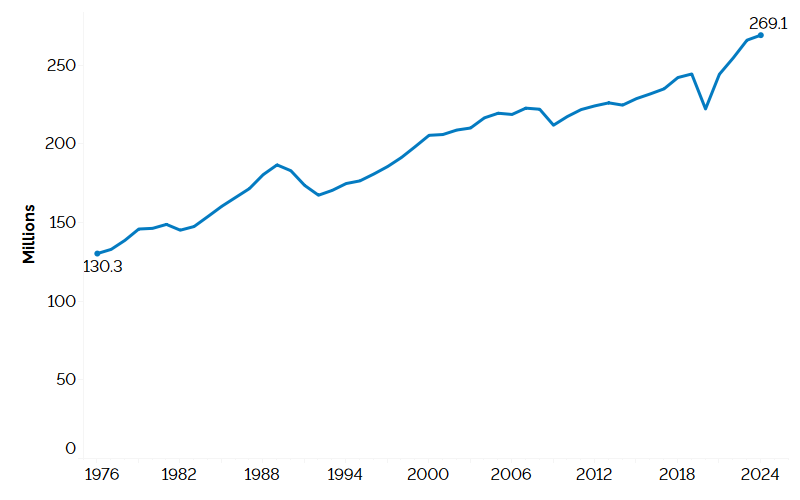
The line chart shows Ontario’s total weekly hours worked from 1976 through 2024, measured in millions of hours. Ontario’s total weekly hours have risen steadily since 1976 with a few exceptions before the 2000s and when hours worked declined in 2008, 2009, 2014 and 2020. The decrease in total weekly hours worked from 2019 to 2020 was sharper compared to previous declines. Total weekly hours worked increased from 130.3 million weekly hours in 1976 to 269.1 million hours in 2024.
In 2024, total weekly hours worked
Unemployment
Unemployment rate by province, 2024
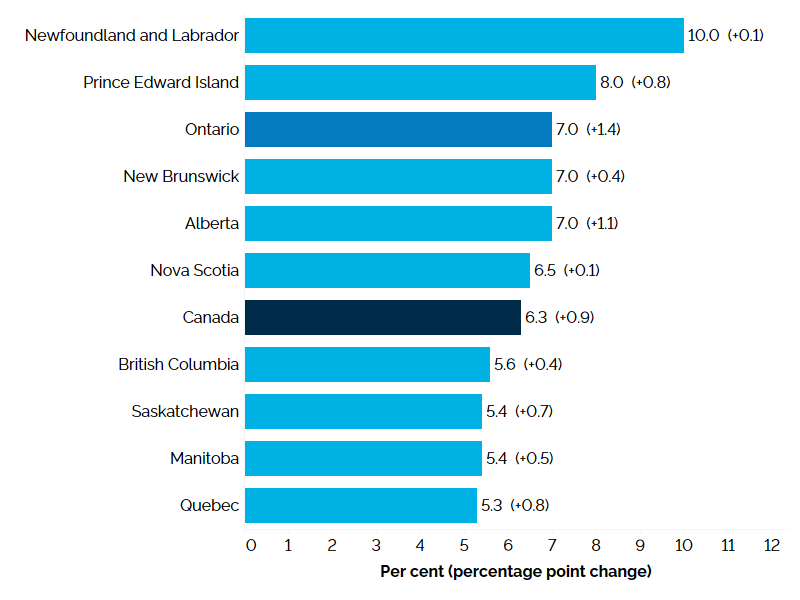
The horizontal bar chart shows unemployment rate by province in 2024, measured in per cent with annual percentage point changes in brackets. Newfoundland and Labrador had the highest unemployment rate at 10.0% (+0.1 percentage point), followed by Prince Edward Island at 8.0% (+0.8 percentage point), and Ontario tied with New Brunswick and Alberta at 7.0% (+1.4, +0.4 and +1.1 percentage points, respectively). Quebec had the lowest unemployment rate at 5.3% (+0.8 percentage point). The national unemployment rate was 6.3% (+0.9 percentage point).
In 2024, all ten provinces experienced an increase in their unemployment rate. Ontario, New Brunswick, and Alberta had the third highest unemployment rates among the ten provinces at 7.0%, but Ontario recorded the largest increase in its unemployment rate (+1.4 percentage points compared to 2023). Ontario’s unemployment rate was 0.7 percentage point above the Canadian rate of 6.3%. Quebec had the lowest unemployment rate (5.3%), and Newfoundland and Labrador had the highest (10.0%).
Unemployment rate by age group, Ontario, 1976-2024
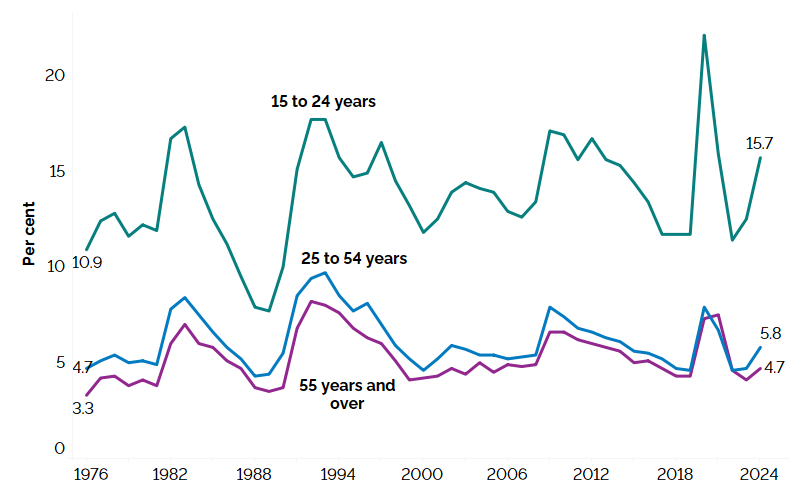
The line chart shows unemployment rates for three groups: youth (15 to 24 years), core-aged (25 to 54 years) and older population (55 years and older) from 1976 to 2024. Compared to 2023, the unemployment rate increased for youth reaching 15.7% in 2024, for the core-aged population (5.8%) and for the older population (4.7%). The unemployment rate of youth has historically been higher than those of the core-aged and older population. In most recent periods, the unemployment rate increased dramatically in 2020 for all three age groups, especially youth.
In 2024, the unemployment rate increased the most for youth aged 15 to 24 years (+3.2 percentage points), followed by the core-aged population aged 25 to 54 years (+1.1 percentage points) and the older population aged 55 years and over (+0.6 percentage point). Youth had the highest unemployment rate (15.7%), followed by the core-aged population (5.8%) and older population (4.7%). Excluding the pandemic years of 2020 and 2021, the youth unemployment rate hit its highest level in 2024 since 2012, while the unemployment rate for core-aged workers reached its highest point since 2014.
Share of long-term unemployment, Ontario, 1976-2024
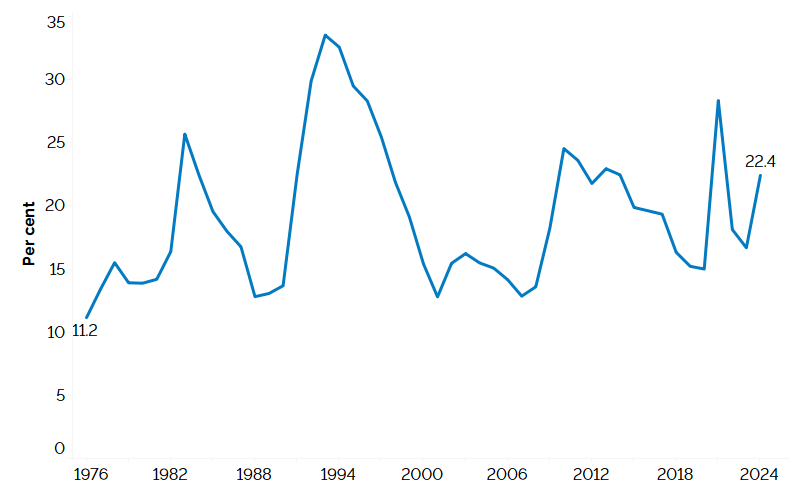
The line chart shows the share of those unemployed for long term as a share of total unemployment from 1976 to 2024, measured in per cent. The share has fluctuated over this time frame. It was 11.2% in 1976, peaking during the periods of the early 1990’s, 2008 and most recently in 2021. The 2024 share of long-term unemployment in Ontario was 22.4%, higher than the 2023 rate but below the 2021 rate.
In 2024, long-term unemployment (unemployed for 27 weeks or more) as a share of total unemployment increased to 22.4% (+5.7 percentage points). This marks the highest rate of long-term unemployment since 2014 (excluding the post-pandemic peak of 28.3% in 2021).
The average duration of unemployment in 2024 was 20.9 weeks, 3.3 weeks longer than the average in 2023 (17.6 weeks).
Participation rates
Participation rate by province, 2024
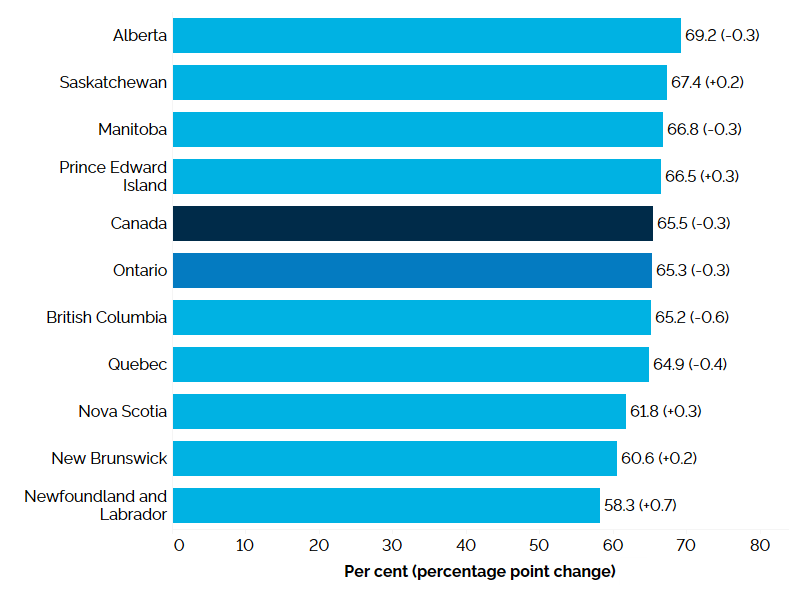
The horizontal bar chart shows the participation rate by province in 2024, measured in per cent with percentage point changes from the previous year in brackets. Alberta had the highest participation rate at 69.2% (-0.3 percentage point), followed by Saskatchewan at 67.4% (+0.2 percentage point), and Manitoba at 66.8% (-0.3 percentage point). Newfoundland and Labrador had the lowest participation rate at 58.3% (+0.7 percentage point). Ontario had the fifth highest participation rate at 65.3% (-0.3 percentage point), slightly below the national rate of 65.5% (-0.3 percentage point).
In 2024, Ontario’s participation rate for people aged 15 years and over was 65.3%, a decrease of 0.3 percentage point compared to 2023. This may reflect that while the labour force increased substantially (+3.2%), it did not keep pace with the LFS population growth (+3.8%). The participation rate in Ontario was slightly below the Canadian average (65.5%) and ranked fifth out of the ten provinces. Ontario was one of the five provinces that experienced a decline in its participation rate in 2024, while the other provinces experienced an increase.
Ontario’s participation rate has declined since 2003, in part due to an aging population. While the participation rate increased temporarily following the pandemic, it declined in 2024 to a level similar to the pre-pandemic level (2019).
In 2024, there were 186,800 people who wanted work but were not part of the labour force
Participation rate by gender, Ontario, 1976-2024
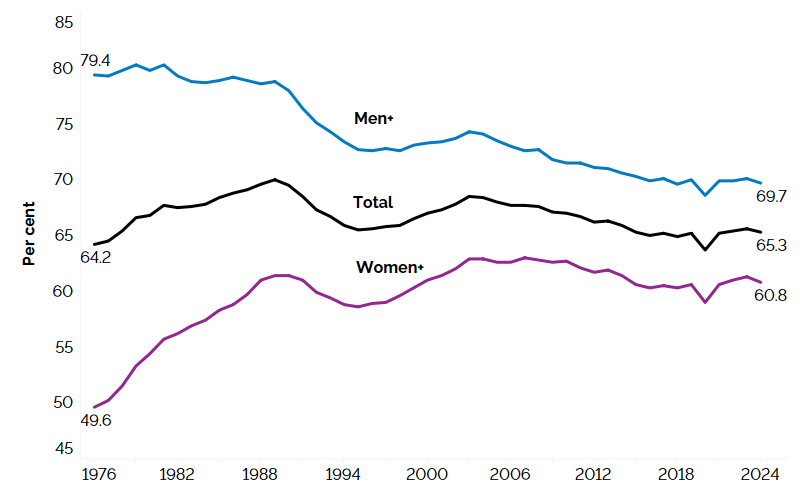
The line chart shows participation rates for the total population, men+, and women+ from 1976 to 2024, measured in per cent. The participation rate of men+ has historically been higher than that of women+. The participation rate of men+ declined from 79.4% in 1976 to 69.7% in 2024, slightly below the 2023 rate. The participation rate of the total population increased from 64.2% in 1976 to 65.3% in 2024, slightly below the 2023 rate. The participation rate of women+ increased from 49.6% in 1976 to 60.8% in 2024, also slightly below the 2023 rate. The participation rates by gender declined in 2020 and then rebounded.
In 2024, the participation rate for men declined by 0.4 percentage point to 69.7%, while the rate for women decreased by 0.5 percentage point to 60.8%. Excluding 2020 (the onset of the pandemic), the participation rate of men in 2024 reached its second-lowest rate historically.
Participation rate by age group, Ontario, 1976-2024
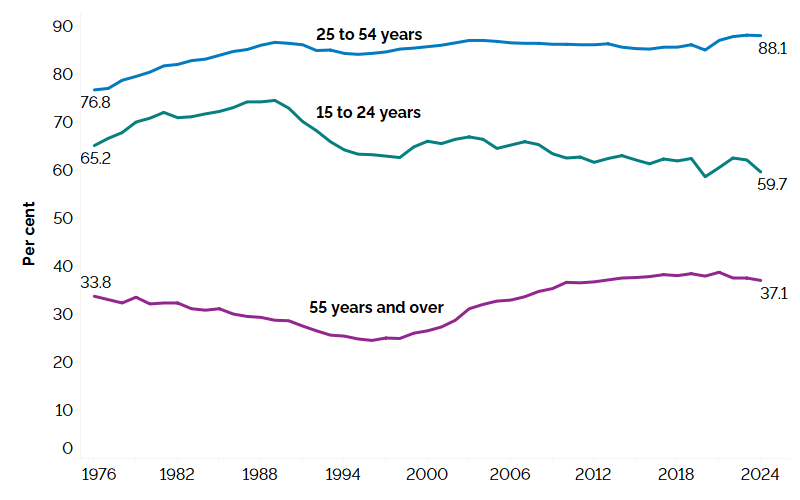
The line chart shows the participation rate for the three age groups: youth (15 to 24 years), core-aged people (25 to 54 years) and the older population (55 years and older) from 1976 to 2024, measured in per cent. The participation rate of the core-aged population increased from 76.8% in 1976 to 88.1% in 2024. The participation rate of youth decreased from 65.2% in 1976 to 59.7% in 2024. The participation rate of the older population increased from 33.8% in 1976 to 37.1% in 2024.
In 2024, the participation rate of the core-aged population edged down by 0.1 percentage point to 88.1%, following a peak of 88.2% in 2023. Youth experienced a decrease in their participation rate by 2.5 percentage points to 59.7%, marking the lowest point on record since 1976 (excluding the pandemic low in 2020). The decline in the youth participation rate drove the overall decline in the participation rate in 2024. The participation rate for the older population declined by 0.5 percentage point to 37.1%.
Methodological note
In this report, year-over-year change represents change between 2023 and 2024. Longer-term trends are included for select labour market characteristics to provide historical context.
All estimates in the report are based on Statistics Canada’s Labour Force Survey (LFS), which measures the current state of the national, provincial and territorial labour market. The LFS is based on a household survey carried out monthly by Statistics Canada in reference weeks of the month. All estimates in this report include the population aged 15 years and over, unless otherwise indicated.
Starting with the 2025 revisions, LFS estimates incorporate the concept of gender, which was introduced in the 2021 Census of Population and added to the LFS questionnaire in January 2022. Estimates prior to 2022 are based on sex of person, while those from 2022 onward are based on gender of person. Although gender and sex at birth are two different concepts, this change does not cause a significant break in the trend because the two concepts produce very similar distributions. All data products from the LFS now adopt the term “gender” for all years and periods.
Given that the non-binary population is small, individuals in the category “non-binary persons” are distributed into the other two gender categories and are denoted by the “+” symbol. The category “Men+” includes men, as well as some non-binary persons, while the category “Women+” includes women, as well as some non-binary persons.
Appendix
10-year overview of annual employment
| 2015 | 2016 | 2017 | 2018 | 2019 | 2020 | 2021 | 2022 | 2023 | 2024 | |
|---|---|---|---|---|---|---|---|---|---|---|
| Total Labour Force (000) | 7,366.0 | 7,422.0 | 7,568.3 | 7,674.2 | 7,848.0 | 7,805.6 | 8,060.1 | 8,221.5 | 8,483.8 | 8,754.7 |
| Participation Rate (%) | 65.3 | 65.0 | 65.2 | 64.9 | 65.2 | 63.7 | 65.2 | 65.4 | 65.6 | 65.3 |
| Men+ Participation Rate (%) | 70.3 | 69.9 | 70.1 | 69.6 | 70.0 | 68.6 | 69.9 | 69.9 | 70.1 | 69.7 |
| Women+ Participation Rate (%) | 60.6 | 60.3 | 60.5 | 60.3 | 60.6 | 59.0 | 60.6 | 61.0 | 61.3 | 60.8 |
| Total Employment (000) | 6,862.7 | 6,934.5 | 7,109.2 | 7,240.4 | 7,412.9 | 7,043.4 | 7,404.8 | 7,764.1 | 8,006.1 | 8,146.1 |
| Full-time (000) | 5,561.7 | 5,611.6 | 5,735.1 | 5,883.8 | 6,036.8 | 5,821.7 | 6,111.0 | 6,411.1 | 6,632.4 | 6,711.0 |
| Part-time (000) | 1,301.0 | 1,323.0 | 1,374.1 | 1,356.6 | 1,376.1 | 1,221.7 | 1,293.8 | 1,353.0 | 1,373.8 | 1,435.1 |
| Employment-Population Ratio (%) | 60.9 | 60.7 | 61.2 | 61.2 | 61.6 | 57.5 | 59.9 | 61.8 | 62.0 | 60.7 |
| Men+ Employment (000) | 3,596.1 | 3,640.5 | 3,736.2 | 3,813.6 | 3,901.2 | 3,738.2 | 3,910.2 | 4,094.1 | 4,230.2 | 4,298.2 |
| Women+ Employment (000) | 3,266.6 | 3,294.0 | 3,373.0 | 3,426.8 | 3,511.6 | 3,305.3 | 3,494.6 | 3,670.0 | 3,776.0 | 3,847.9 |
| Part-Time (% of total) | 19.0 | 19.1 | 19.3 | 18.7 | 18.6 | 17.3 | 17.5 | 17.4 | 17.2 | 17.6 |
| Goods-Producing Sector Employment (000) | 1,401.7 | 1,435.6 | 1,463.5 | 1,482.3 | 1,476.3 | 1,423.5 | 1,480.9 | 1,558.9 | 1,619.0 | 1,583.5 |
| Services-Producing Sector Employment (000) | 5,461.0 | 5,499.0 | 5,645.7 | 5,758.1 | 5,936.5 | 5,620.0 | 5,923.9 | 6,205.2 | 6,387.2 | 6,562.6 |
| Private Sector Employment (000) | 4,548.4 | 4,621.6 | 4,749.2 | 4,818.7 | 4,931.6 | 4,614.0 | 4,876.3 | 5,153.1 | 5,367.3 | 5,421.7 |
| Public Sector Employment (000) | 1,264.4 | 1,262.9 | 1,278.7 | 1,311.6 | 1,343.2 | 1,332.0 | 1,441.0 | 1,540.9 | 1,570.1 | 1,622.2 |
| Self-Employment (%of total) | 15.3 | 15.1 | 15.2 | 15.3 | 15.4 | 15.6 | 14.7 | 13.8 | 13.3 | 13.5 |
| Total Unemployment (000) | 503.2 | 487.5 | 459.1 | 433.8 | 435.1 | 762.1 | 655.3 | 457.4 | 477.7 | 608.6 |
| Unemployment Rate (%) | 6.8 | 6.6 | 6.1 | 5.7 | 5.5 | 9.8 | 8.1 | 5.6 | 5.6 | 7.0 |
| Men+ Unemployment Rate (%) | 7.1 | 6.8 | 6.3 | 5.6 | 5.7 | 9.6 | 8.1 | 5.5 | 5.5 | 7.3 |
| Women+ Unemployment Rate (%) | 6.5 | 6.3 | 5.8 | 5.7 | 5.4 | 10.0 | 8.2 | 5.7 | 5.8 | 6.5 |
| Long-Term (27 wks+) (% of total) | 19.9 | 19.6 | 19.3 | 16.3 | 15.2 | 15.0 | 28.3 | 18.1 | 16.7 | 22.4 |
| Average Unemployment in Weeks | 20.2 | 19.8 | 19.1 | 17.2 | 16.0 | 15.4 | 23.0 | 19.7 | 17.6 | 20.9 |
| Youth Unemployment Rate (%) | 14.4 | 13.4 | 11.7 | 11.7 | 11.7 | 22.1 | 15.9 | 11.4 | 12.5 | 15.7 |
| 25-54 y.o. Unemployment rate (%) | 5.6 | 5.5 | 5.2 | 4.7 | 4.6 | 7.9 | 6.7 | 4.6 | 4.7 | 5.8 |
| 55+ y.o. Unemployment rate (%) | 5.0 | 5.1 | 4.7 | 4.3 | 4.3 | 7.3 | 7.5 | 4.6 | 4.1 | 4.7 |
| Average Weekly Wage Rate ($) | 959.34 | 984.76 | 992.85 | 1,030.78 | 1,059.89 | 1,138.00 | 1,164.85 | 1,218.08 | 1,279.16 | 1,339.01 |
| Average Hourly Wage Rate ($) | 26.18 | 26.89 | 27.14 | 28.18 | 28.97 | 30.90 | 31.66 | 32.97 | 34.63 | 36.44 |
Employment by region (000)
| 2015 | 2016 | 2017 | 2018 | 2019 | 2020 | 2021 | 2022 | 2023 | 2024 | |
|---|---|---|---|---|---|---|---|---|---|---|
| Greater Toronto Area | 3,277.1 | 3,316.0 | 3,386.2 | 3,459.4 | 3,550.4 | 3,367.9 | 3,525.6 | 3,673.7 | 3,787.6 | 3,852.0 |
| Central | 1,583.6 | 1,587.7 | 1,666.3 | 1,675.1 | 1,707.9 | 1,627.2 | 1,713.4 | 1,815.6 | 1,879.5 | 1,901.0 |
| Southwest | 772.6 | 783.5 | 795.2 | 820.9 | 821.4 | 778.2 | 843.7 | 883.9 | 908.5 | 940.3 |
| East | 882.0 | 899.4 | 907.3 | 923.6 | 970.4 | 920.5 | 967.3 | 1,017.3 | 1,052.7 | 1,072.5 |
| North | 347.5 | 348.2 | 354.2 | 361.4 | 362.7 | 349.6 | 354.9 | 373.5 | 377.7 | 380.3 |
Unemployment rate by region (%)
| 2015 | 2016 | 2017 | 2018 | 2019 | 2020 | 2021 | 2022 | 2023 | 2024 | |
|---|---|---|---|---|---|---|---|---|---|---|
| Greater Toronto Area | 7.2 | 6.9 | 6.5 | 6.0 | 5.9 | 11.0 | 9.1 | 6.3 | 6.2 | 7.9 |
| Central | 5.9 | 5.9 | 5.3 | 5.3 | 5.2 | 9.0 | 7.5 | 5.0 | 5.2 | 6.2 |
| Southwest | 7.0 | 6.1 | 5.7 | 5.3 | 5.4 | 9.2 | 7.5 | 5.5 | 5.6 | 6.4 |
| East | 6.8 | 6.5 | 5.9 | 4.9 | 5.0 | 7.7 | 6.5 | 4.4 | 4.6 | 5.7 |
| North | 7.2 | 7.4 | 6.5 | 6.1 | 6.0 | 8.0 | 6.8 | 4.6 | 5.2 | 5.5 |
Total employment by CMA (000)
Greater Toronto Area
| 2015 | 2016 | 2017 | 2018 | 2019 | 2020 | 2021 | 2022 | 2023 | 2024 | |
|---|---|---|---|---|---|---|---|---|---|---|
| Toronto | 3,120.1 | 3,145.1 | 3,223.9 | 3,284.6 | 3,380.3 | 3,198.5 | 3,353.6 | 3,498.2 | 3,613.0 | 3,669.5 |
| Oshawa | 192.0 | 209.3 | 205.6 | 214.4 | 213.6 | 207.4 | 215.1 | 233.8 | 235.6 | 242.3 |
Central Ontario
| 2015 | 2016 | 2017 | 2018 | 2019 | 2020 | 2021 | 2022 | 2023 | 2024 | |
|---|---|---|---|---|---|---|---|---|---|---|
| Hamilton | 380.0 | 379.9 | 411.5 | 407.9 | 416.5 | 390.4 | 417.9 | 427.7 | 424.9 | 433.3 |
| Kitchener-Cambridge-Waterloo | 289.8 | 292.3 | 303.8 | 311.9 | 322.2 | 304.5 | 322.5 | 338.7 | 358.0 | 381.4 |
| St. Catharines-Niagara | 205.1 | 205.8 | 204.8 | 210.6 | 209.3 | 192.5 | 203.0 | 228.4 | 233.1 | 233.5 |
| Peterborough | 60.1 | 58.4 | 61.8 | 65.0 | 62.3 | 53.1 | 62.6 | 66.0 | 67.9 | 66.8 |
| Brantford | 69.7 | 70.1 | 72.7 | 70.7 | 79.3 | 73.4 | 76.8 | 81.8 | 84.3 | 85.2 |
| Guelph | 89.6 | 90.9 | 91.5 | 89.7 | 92.4 | 86.8 | 95.0 | 99.6 | 103.6 | 103.0 |
| Barrie | 106.0 | 102.5 | 114.2 | 111.8 | 117.2 | 119.2 | 117.1 | 128.1 | 136.1 | 132.3 |
Eastern Ontario
| 2015 | 2016 | 2017 | 2018 | 2019 | 2020 | 2021 | 2022 | 2023 | 2024 | |
|---|---|---|---|---|---|---|---|---|---|---|
| Ottawa-Gatineau (Ontario part) | 554.0 | 566.5 | 574.5 | 589.6 | 616.4 | 587.9 | 620.3 | 642.0 | 677.0 | 693.2 |
| Kingston | 79.8 | 80.4 | 85.6 | 84.9 | 85.9 | 81.9 | 82.7 | 89.2 | 93.3 | 93.3 |
| Belleville | 32.4 | 33.3 | 41.0 | 41.8 | 51.8 | 50.6 | 51.6 | 60.5 | 63.1 | 44.8 |
Southwestern Ontario
| 2015 | 2016 | 2017 | 2018 | 2019 | 2020 | 2021 | 2022 | 2023 | 2024 | |
|---|---|---|---|---|---|---|---|---|---|---|
| London | 248.6 | 244.9 | 248.2 | 258.5 | 256.4 | 259.1 | 283.7 | 300.5 | 315.5 | 321.5 |
| Windsor | 192.3 | 201.1 | 198.2 | 205.3 | 207.6 | 181.3 | 202.1 | 210.0 | 232.3 | 237.2 |
Northern Ontario
| 2015 | 2016 | 2017 | 2018 | 2019 | 2020 | 2021 | 2022 | 2023 | 2024 | |
|---|---|---|---|---|---|---|---|---|---|---|
| Greater Sudbury | 83.3 | 83.1 | 83.0 | 84.2 | 88.1 | 82.0 | 83.6 | 88.3 | 91.4 | 90.2 |
| Thunder Bay | 59.4 | 60.1 | 62.2 | 64.8 | 63.6 | 59.8 | 61.8 | 62.9 | 65.4 | 65.0 |
Note: All estimates in this appendix are based on Statistics Canada’s Labour Force Survey.
Footnotes
- footnote[1] Back to paragraph Public sector includes the federal, provincial, territorial and local general governments, health and social service institutions, universities, colleges, vocational and trade institutions, school boards, and government business enterprises.
- footnote[2] Back to paragraph BuildForce Canada. September 17, 2024. National construction employment softens in August, led by sharp contractions in Ontario.
- footnote[3] Back to paragraph Occupation estimates are based on the 2021 National Occupational Classification. Management occupations are classified under the management occupational category and the remaining categories exclude management occupations.
- footnote[4] Back to paragraph See Methodological Note for information on gender collection and reporting.
- footnote[5] Back to paragraph Starting in 2006, enhancements to the Labour Force Survey processing system have introduced a level shift in average and median wages. Caution should be used when comparing estimates before and after 2006.
- footnote[6] Back to paragraph Real wages are based on nominal wages deflated by the Ontario Consumer Price Index (CPI) for all items. Self-employment is excluded.
- footnote[7] Back to paragraph Real wages are based on nominal wages deflated by the Ontario Consumer Price Index (CPI) for all items. Self-employment is excluded.
- footnote[8] Back to paragraph This is a 12-month average of the total number of hours actually worked by all employed persons in all jobs in the Labour Force Survey reference weeks.
- footnote[9] Back to paragraph Despite wanting to work, some people might not look for a job due to reasons like illness, personal/family responsibilities, school, awaiting recall/reply, discouraged, and other factors.